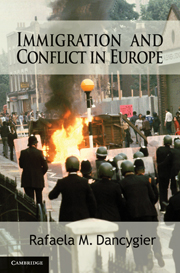Book contents
- Frontmatter
- Contents
- List of Figures and Tables
- Acknowledgments
- PART I GENERAL INTRODUCTION AND THEORETICAL FRAMEWORK
- PART II INTRODUCTION TO PART II
- PART III INTRODUCTION TO PART III
- PART IV INTRODUCTION TO PART IV
- 9 Conclusion
- Appendix A Coding Large-Scale Instances of Immigrant–Native and Immigrant–State Violence
- Appendix B Data and Variables: Immigrant Turnout
- References
- Index
- Titles in the series
Appendix B - Data and Variables: Immigrant Turnout
Published online by Cambridge University Press: 17 November 2010
- Frontmatter
- Contents
- List of Figures and Tables
- Acknowledgments
- PART I GENERAL INTRODUCTION AND THEORETICAL FRAMEWORK
- PART II INTRODUCTION TO PART II
- PART III INTRODUCTION TO PART III
- PART IV INTRODUCTION TO PART IV
- 9 Conclusion
- Appendix A Coding Large-Scale Instances of Immigrant–Native and Immigrant–State Violence
- Appendix B Data and Variables: Immigrant Turnout
- References
- Index
- Titles in the series
Summary
The 2003 Home Office Citizenship Survey: People, Families and Communities contains a nationally representative sample of around 10,000 people over sixteen years of age living in England and Wales and an oversample of ethnic minorities of around 5,000 respondents.
Sample Used in Models
Respondents are British citizens born outside of the United Kingdom.
The (unweighted) sample contains 1,004 South Asian and 898 black respondents.
Dependent Variables
Local election turnout: “Can I check, did you vote in the last local council election?”
An answer of “yes” was coded as 1, and “no” was coded as 0.
General election turnout: “Can I check, did you vote in the last general election?”
An answer of “yes” was coded as 1, and “no” was coded as 0.
Independent Variables
The self-reported ethnic origins of the respondents (dummy variables) are listed here.
- Type
- Chapter
- Information
- Immigration and Conflict in Europe , pp. 301 - 304Publisher: Cambridge University PressPrint publication year: 2010

